 |
 |
| 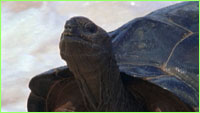
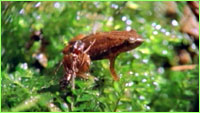 The
giant tortoise and the ant-sized frog, both native to the Seychelles, exemplify
what can happen to species that wash ashore on islands free of their own
kind. (Note the ant clinging to the frog's hindquarters.)
The
giant tortoise and the ant-sized frog, both native to the Seychelles, exemplify
what can happen to species that wash ashore on islands free of their own
kind. (Note the ant clinging to the frog's hindquarters.)
|
Why Do Islands Breed Giants (And Sometimes Dwarfs)?
by Peter Tyson
The giant tortoise and the frog the size of an ant, both native to the
Seychelles, exemplify something that happens to animal species that succeed in
colonizing new islands: Over time, in their new home, many of them tend to
become either gigantic or dwarfed.
Island giants are aplenty: Komodo has its dragons. Madagascar has its giant
hissing cockroach. Until about 1,000 years ago, New Zealand had its colossal
bird, the moa. Of dwarves, the world has witnessed everything from foxes,
rabbits, and snakes that are smaller than their mainland counterparts, to that
ultimate oxymoron, the pygmy mammoth, which once existed in various forms from
California's Channel Islands to Wrangel Island in the Siberian Arctic.
Why does this happen? What factors encourage a species to alter its dimensions
on islands? What determines whether a creature will get Brobdingnagian or
Lilliputian?
The island rule
|
|
Number of Species or Subspecies |
| Smaller |
Same |
Larger |
|
| Marsupials |
0 |
1 |
3 |
| Insectivores |
4 |
4 |
1 |
| Lagomorphs |
6 |
1 |
1 |
| Rodents |
6 |
3 |
60 |
| Carnivores |
13 |
1 |
1 |
| Artiodactyls |
9 |
2 |
0 |
|
Table showing relative sizes of island-dwelling
mammal species and subspecies as compared with their presumed mainland
relatives.
Source: Foster, J. Bristol, "Evolution of Mammals on Islands," Nature, Vol. 202, April 18, 1964.
|
The first attempt to account for this apparent evolutionary roulette was made
in 1964 by a young biologist named J. Bristol Foster. Fresh out of a doctoral
program at the University of British Columbia, Foster published a brief but
influential paper in the journal Nature entitled "Evolution of Mammals
on Islands." Claiming "much confusion and contradiction" in the scientific
literature on the size of mammals on islands, Foster undertook a survey of 116
insular (island-dwelling) species or subspecies living mostly off the coasts of
western North America and Europe. He summarized his findings in the table at
right, which indicates whether an island critter is daintier, similarly sized,
or brawnier than its presumed mainland ancestor.
The table reveals some interesting trends. Rodents tend toward gigantism, while
carnivores, lagomorphs (rabbits and hares), and artiodactyls (deer, hippos, and
other even-toed ungulates) are more likely to become dwarfed. Overall, amongst
mammal species that colonize islands, big ones have a tendency to shrink while
small ones are apt to bulk up. Biologists have come to call Foster's
generalization the "island rule."
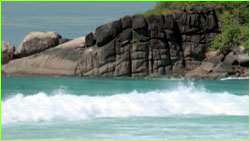 J. Bristol Foster only began to
unravel what factors determine whether a species of animal newly arrived on an
island will become gigantic, dwarfed, or neither.
J. Bristol Foster only began to
unravel what factors determine whether a species of animal newly arrived on an
island will become gigantic, dwarfed, or neither.
|
|
With the caution of a child testing a hot bath with an exploratory toe,
Foster went on to offer tentative explanations as to how at least some of these
extraordinary transformations occurred. Islands, he argued, contain fewer
species than mainlands and thus fewer numbers of both predators and competitors
that might face a newcomer. "In such situations," he wrote, "it appears that
the larger rodent has an advantage." But how to explain those species that
diminish in size? Foster offered one possible answer, and that for just one
group, the artiodactyls. While rodents are able to control their populations in
the absence of predators, hippos and deer and their kind cannot. As a result,
artiodactyls are "especially susceptible," he wrote, to exhausting food
resources and occasioning malnutrition and stunting in their young. If, in
succeeding generations, smaller individuals met with greater reproductive
success, then eventually evolution might begin to favor them, leading to
dwarfism.
Foster's modest paper represented, as David Quammen puts it in his book
The Song of the Dodo, "a sort of prerevolutionary innocence,
standing on the distant side of a major upheaval." That upheaval was the 1967
publication of The Theory of Island Biogeography, by Robert MacArthur
and Edward O. Wilson. The book not only launched an entirely new field of
scientific endeavor—the study of how insular plants and animals got to be
where they are today—but spurred a host of young biologists to tackle the
gigantism/dwarfism question.
| 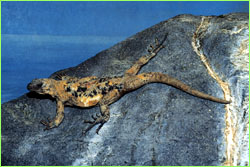 Three times larger than its closest
mainland relative, the roughly two-pound giant chuckwalla has gone in for
gigantism in, well, a big way.
Three times larger than its closest
mainland relative, the roughly two-pound giant chuckwalla has gone in for
gigantism in, well, a big way.
|
One of those young scientists was Ted J. Case. Like Foster, Case published a
seminal paper early in his career (1978) in a leading scientific journal
(Ecology). But his paper was much longer—19 pages compared to
Foster's two—and, against Foster's lone table, it offered numerous graphs,
tables, and complex mathematical equations. In his paper, Case acknowledged
Foster's pioneering work, then pointed out where his predecessor's analysis
fell short. For example, new data indicates that Foster's generalization about
island-dwelling meat-eaters may not hold up, Case stated, and Foster never even
mentioned the tendency for elephants to dwarf on islands. Case, who studies an
iguana-like reptile known as the giant chuckwalla, also noted that no one had
yet published a tally of size change in reptiles like that Foster had done for
mammals.
Most important, Case stressed glaring exceptions to the island rule: how the
same lizard or rodent could be relatively large on some islands but not on
others, and how one island may have gigantic forms of one type of lizard or
rodent and dwarf races of another. As an example of the latter scenario, he
cited the curious case of two rattlesnake species that cohabit Angel de la
Guarda, one of the sun-baked desert islands in the Gulf of California where he
studies the chuckwalla. On the nearby Mexican mainland, Crotalus ruber
is roughly twice the size of C. mitchelli, but on Angel de la Guarda,
the situation is exactly reversed, with C. mitchelli about two times as
big as C. ruber. How did this happen? Judging from a close look at the
two species, C. mitchelli appears to have diverged more from its
mainland progenitor than has C. ruber, Case says, which implies that
C. mitchelli arrived first on Angel de la Guarda. In order to make use
of all available prey, C. mitchelli went in for a larger size. When
C. ruber finally reached the island, it found the big-rattlesnake niche
already taken. So it had to settle on the little-rattlesnake niche, and it
evolved a smaller frame to do so.
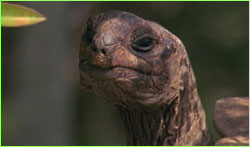 From the looks of it, nothing has stopped the species of giant tortoise found
in the Seychelles from growing just as big as it wants.
From the looks of it, nothing has stopped the species of giant tortoise found
in the Seychelles from growing just as big as it wants.
|
|
Bearing such anomalies in mind, Case concluded in his paper that "[a]ny theory
proposing to account for these insular size trends must also be consistent with
their numerous exceptions." In those 18 pages of small print, Case elaborately
spun out such a theory. The chief factor that underlies all modifications in
body size, he argued, is the net amount of energy that an animal can gain in a
given amount of time. All changes proceed from that, yet all kinds of other
factors also come into play to decide whether that animal becomes brawnier or
daintier. And, practicing what he preached, Case allowed for exceptions to his
modification of Foster's rule. For example, if an ever-increasing size in
species undergoing gigantism eventually were to interfere with, say, that
creature's ability to fly (in birds) or climb (in geckos) or burrow (in
rodents), then that species would enlarge only up to the point where these
other factors become of overriding importance.
Continue: Blazing the Trail
Seychelles Through Time |
Saving the Magpie Robin
Why Do Islands Breed Giants? |
Build an Island
Resources |
Transcript |
Site Map |
Garden of Eden Home
Editor's Picks |
Previous Sites |
Join Us/E-mail |
TV/Web Schedule
About NOVA |
Teachers |
Site Map |
Shop |
Jobs |
Search |
To print
PBS Online |
NOVA Online |
WGBH
© | Updated November 2000
|
|
|